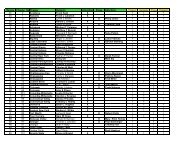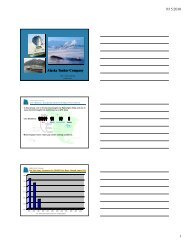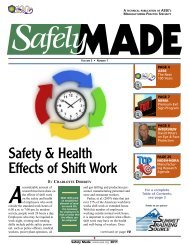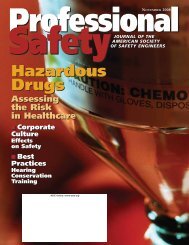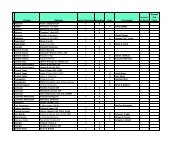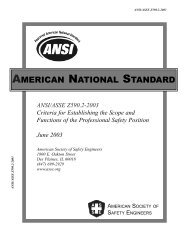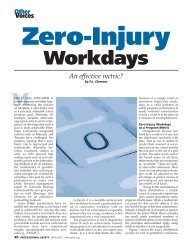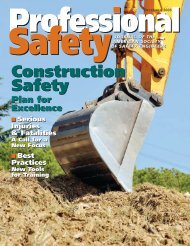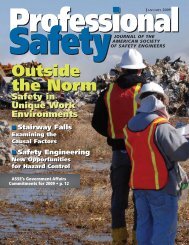OSHA's Flame-Resistant Clothing Policy - ASSE Members
OSHA's Flame-Resistant Clothing Policy - ASSE Members
OSHA's Flame-Resistant Clothing Policy - ASSE Members
You also want an ePaper? Increase the reach of your titles
YUMPU automatically turns print PDFs into web optimized ePapers that Google loves.
the interpretations take on a more prescriptive approachto regulating oil and gas well drilling, servicing and production-relatedoperations.OSHA is within its right to enforce and clarify policywhen appropriate; however, both the March and October2010 interpretations imply an expansion of OSHA’s charterbeyond simply performing a public service. It is herewhere the second implication exists, “Is it OSHA’s role tobecome a subject matter expert when it comes to identifyinga risk and controlling hazards for a specific industry?”Codifying measures to protect workers and the communityfor potential risks is clearly warranted, but where is the dueprocess of rulemaking? The role of the safety professionalin guiding employers to a successful outcome to preventrisk becomes less clear if the experts for specific industrysegments become those who write and enforce the rules(i.e., it is like having the fox watch the henhouse).CONCLUSIONThis article is not intended to criticize the agency, butis intended to present a perspective of potential unintendedconsequences of the recent interpretations relative topolicy. At a minimum, these more recent interpretationsleave little room for the oil and gas industry to controlrisk using a hazard assessment and process knowledge,which becomes not only troublesome for safety professionals,but also limits the ability for an organization tomanage resources and control cost. In summary, theauthor is concerned about two implications regarding the2010 OSHA interpretations on the use of FRC. The firstis that there may be a prima facie form of regulating theoil and gas industry without stakeholder consensus ordue process, and the second is that identification andcontrol of hazards have become more difficult for theAmerican industry in which to demonstrate a comprehensiveand robust assessment to achieve compliance.As OSHA turned 40 last year, Assistant SecretaryDavid Michaels’s and Department of Labor SecretaryHilda Solis’s strategies focus on stronger enforcement,whereas some employers need incentives to do the rightthing (OSHA, 2010). The author believes in strongerenforcement and penalties to deter complacent employers;however, let us reflect on where the energy industryis going as safety professionals, for where it came hasbeen through programs, such as PSM, hazard communication,safety by committee and performance-basedmethods, which have matriculated in numerous voluntaryprotection programs and management systems certificationswhere companies have been recognized for ajob well done. These programs motivate consensusbuilding and create the best companies in the world.This is an industry built on “roughnecks” and“roustabouts” who have a “git-r-dun” work ethic, whoare not only “pencil pushers” or “white-collar workers,”but are “salt-of-the-earth” people, Americans who workin some of the most wild and remote areas on earth. Weshould always keep in mind what the President said in arecent State of the Union address, “. . . to help our companiescompete, we also have to knock down barriersthat stand in the way of their success.” All governmentregulations are by the people and for the people—maybeit is time to consider giving some back to the people(State of the Union Address, 2011). REFERENCESAmerican Institute of Chemical Engineers. (1992,April). Guidelines for hazard evaluation procedures (2nded.). With worked examples, Center of Chemical ProcessSafety, Appendix B—Supplemental questions for hazardevaluations.American Petroleum Institute. (2010, Sept. 20).Energizing America: Facts for addressing energy policy.American Petroleum Institute. (2011, Feb. 17). EnergizingAmerica: Facts for addressing energy policy.Curlee, C.K., Broulliard, S.J., Marshall, M.L., et al.(2005). Upstream onshore oil and gas fatalities: A reviewof OSHA’s database and strategic direction for reducingfatal incidents. Prepared for the 2005 SPE/EPA/DOEExploration and Production Environmental Conference,Galveston, TX, March. 7-9, 2005.Engineering News Record. (2010). BP toughens safetyculture. Retrieved Nov. 16, 2010, from http://enr.construction.com/.Fairfax, R. & Witt, S. (2010, Mar.ch19). Enforcementpolicy for flame-resistant clothing in oil and gas drilling,memorandum to regional administrators state designees.Washington, D.C.: U.S. Department of Labor, OSHA.Maslowski, A. (2010, March/April). The petroleumindustry’s public image. Well Servicing Magazine.Michaels, D. (2010, Jul. 19). OSHA at 40: New challengesand new directions. Comments by the AssistantSecretary, OSHA, U.S. Department of Labor.National Petrochemical & Refiners Association.(2010, April 28). Written statement as submitted to theSubcommittee on Energy and the Environment, U.S.House of Representatives Committee on Energy andCommerce on clean energy policies that reduce ourdependence on oil.Neuman, M. (2011, Jan.). New OSHA sheriff intown. Professional Safety, 8.The White House. (2011, Jan. 25). State of the unionaddress. Washington, DC: Office of the Press Secretary,U.S. Capitol.Christopher S. Clasen, CSP, CFI, CEM, is certified as an ISO14000 and OHSAS 18001 advanced environmental managementsystems auditor and is the owner of CSC Engineering LLC, a professionalenvironmental, fire and safety consulting firm specializingin environmental health and safety (EHS) compliance services.He has more than 25 years’ comprehensive experience in EHS inprivate industry, consulting and public regulatory agencies. Heholds an M.S. in Civil and Environmental Engineering fromCalifornia State University and a B.S. in Mechanical Engineeringfrom the University of California.23Well Informed www.asse.org 2011




